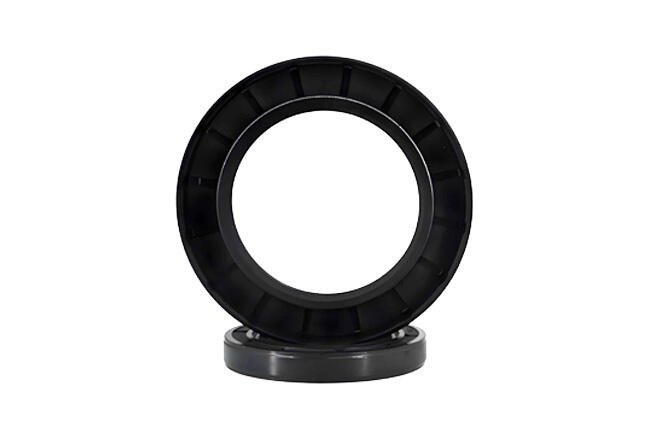When people talk about rotating machinery, they often focus on the “big” parts—gears, shafts, bearings, or motors. But if you have worked in this field long enough, you know the small components often decide whether the machine runs smoothly or not. One of those small but decisive parts is the radial shaft seal, sometimes simply called the oil seal.
A shaft seal does not look impressive at first glance. It is just a ring of elastomer with a spring in some cases. But its function is critical: it keeps oil or grease where it should stay and stops dust, water, or other contaminants from sneaking inside. If the seal fails, bearings wear out faster, gears run dry, and downtime costs rise quickly.
How a Radial Shaft Seal Works in Practice
· The idea is simple. A radial shaft seal sits between the housing and the rotating shaft. The outer surface holds tightly against the bore, while the lip presses against the shaft surface. That contact creates a thin oil film which acts as both a lubricant and a sealing barrier.
· A small garter spring is usually hidden inside the lip, making sure the pressure around the shaft stays uniform. Without it, the lip could lose contact and start leaking after only a short running time. In dusty or wet environments, some seals come with an additional dust lip. This extra lip is not meant to hold back oil; it mainly blocks sand, dirt, or splashing water.
· One detail that often gets overlooked is heat. Friction at the lip generates heat, and if the shaft is rough or the oil film is missing, the seal may burn out very quickly. This is why shaft finishing, lubricant quality, and correct installation are just as important as the seal itself.

What Makes One Seal Different from Another
If you open a catalog, many seals look almost identical. The difference usually lies in the details:
· Material of the lip. Nitrile rubber (NBR) is still common, but higher temperature applications need FKM (Viton) or even PTFE. The choice of material determines resistance to heat, oil additives, or aggressive chemicals.
· Lip design. Some profiles are shaped to “pump” oil back inside, especially in automotive or gearbox applications.
· Outer diameter coating. A thin rubber layer on the outside helps compensate for small housing irregularities and ensures a reliable fit.
· Pressure capability. Standard designs handle only splash and low pressure. For pumps or hydraulic systems, special reinforced seals are needed.
These differences are why two seals with the same size code may perform very differently in the field.
Where You Will Find Radial Shaft Seals
· Gearboxes and reducers – They keep oil inside under continuous load and vibration.
· Automotive axles and steering systems – They work under mixed conditions: road dust, water, and grease.
· Hydraulic pumps and motors – Seals here face both pressure and fluid compatibility challenges.
· Wind turbines – Large main shaft seals prevent grease leakage and protect against weather exposure.
· General machinery – Any rotating shaft that relies on lubrication needs a seal.
Field Examples from Maintenance Work
One case that comes to mind was a crane operating in a coastal port. The gearbox seals were failing every six months, always on the side facing the sea. After inspection, the issue turned out not to be the lip design, but the material. The standard NBR lip was not handling the salt spray and temperature variation. After switching to FKM seals with an extra dust lip, service life tripled.
These stories remind us that a seal is not a stand-alone product. It always works as part of a system.
Often Ask
1. Do you keep stock of standard sizes?
Yes. For the most common dimensions, thousands of pieces are kept on the shelf. That way, maintenance teams and resellers can respond quickly without waiting for production.
2. What about non-standard designs?
Custom seals are possible. Sometimes only a change in material is needed, other times a completely new mold is designed. For OEMs, this is often the path to long-term reliability.
3. How can we reduce warranty risks?
The key is matching the seal to the actual operating conditions, not just the catalog size. Temperature, medium, shaft finish, and pressure all matter. Good communication between supplier and distributor prevents most of the early failures.
4. Why Long-Term Partners Stay with NQKSF
NQKSF has been in sealing technology for over 30 years. The company started with simple oil seals and has grown into a supplier covering O-rings, shaft seals, and custom profiles. What partners value most is not only the product but also:
· A wide ready-to-ship stock program
· Technical support from engineers who have worked on actual field problems
· Production capacity that allows large orders without long delays
· A proven track record in over 80 export markets
Many distributors continue cooperation not because seals are hard to find, but because reliability and support are harder to find.
Radial shaft seals will never be the most expensive component in a machine. But when they fail, they often cause some of the most expensive downtime. That is why experienced engineers and maintenance teams treat them with respect.
For those who distribute or specify sealing products, the value of a reliable partner is clear. With the right design, the right material, and the right supplier, radial shaft seals stop being a weak point and become a quiet guarantee of machine uptime.
 Hot News
Hot News